Abstract
The complete amino acid sequences of the variable regions of three mouse Vκ-21 kappa chains (A22, T111, and CB101) and one partial sequence (B32) have been determined and are compared to four previously reported Vκ-21 variable regions. These eight κ variable region sequences have, with the exception of an amide difference at residue 1, identical amino-terminal 23-residue sequences, all are of the same length, and all have extensive amino acid sequence homology throughout the variable region. When these eight variable regions are grouped by sequence homology, five different groups (Vκ-21A, B, C, D, and E) are present whose members share common sets of amino acids within a group. Three groups of similar homology each contains at least two members (M63 and AB22 in Vκ-21B; M321 and T124 in Vκ-21C; and M70 and B32 in Vκ-21A). The repetition of these five characteristic subgroup sequences in this relatively small sample indicates that these subgroups are isotypes which are controlled by separate germline genes. It is unlikely that these sequences could have been randomly somatically generated in different animals from a single germ-line gene (parallel mutation). Although a limited number of comparisons are available, the sequence differences within the Vκ-21A, B, and C isotypes are limited to complementarity-determining regions and may have resulted from somatic mutations. The κ chains comprising the Vκ-21 isotypes offer a unique opportunity to compare the genetic interpretations of the primary amino acid sequence data with the nucleic acid hybridization data.
Keywords: amino acid sequence, genetics of antibody diversity, Vκ-21 isotype
Full text
PDF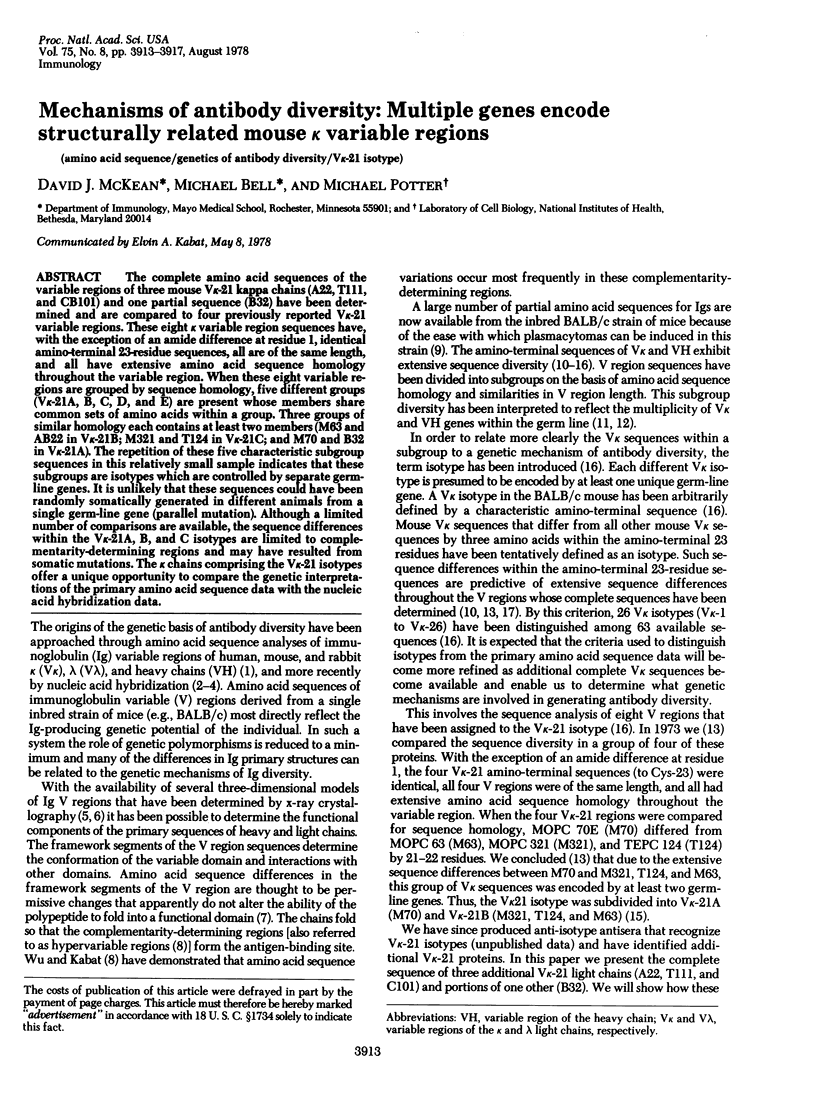
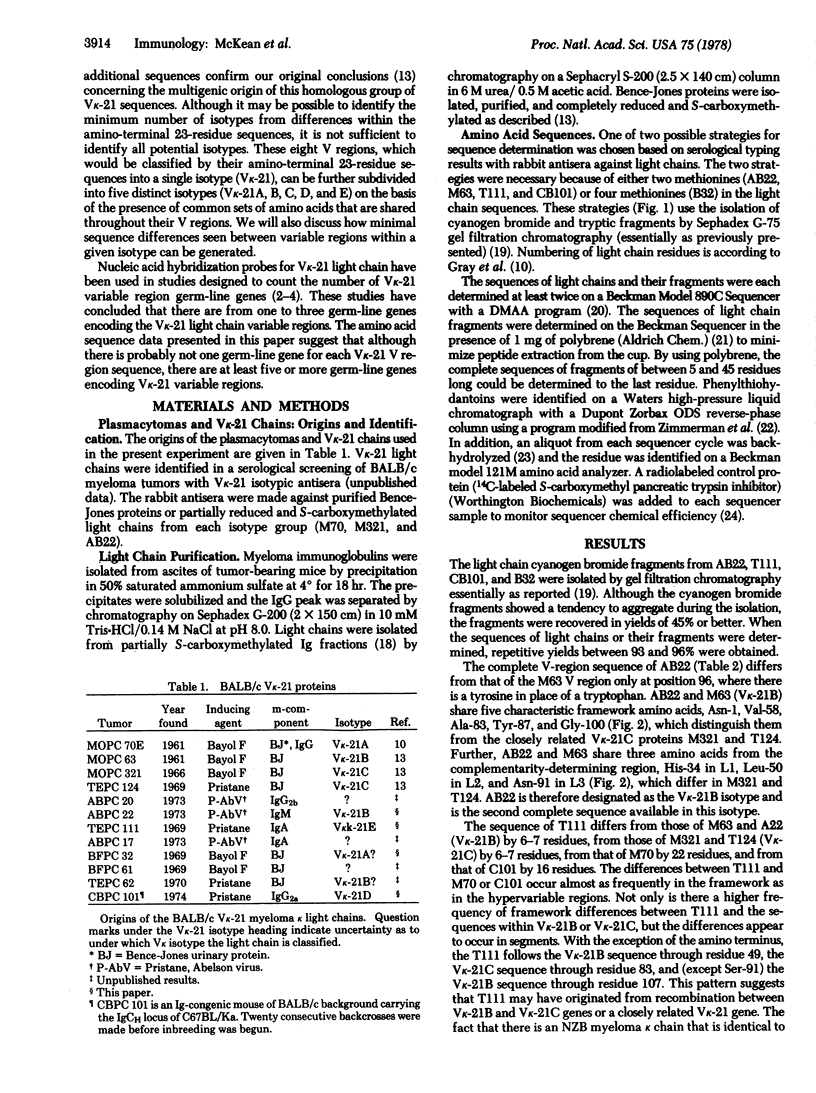
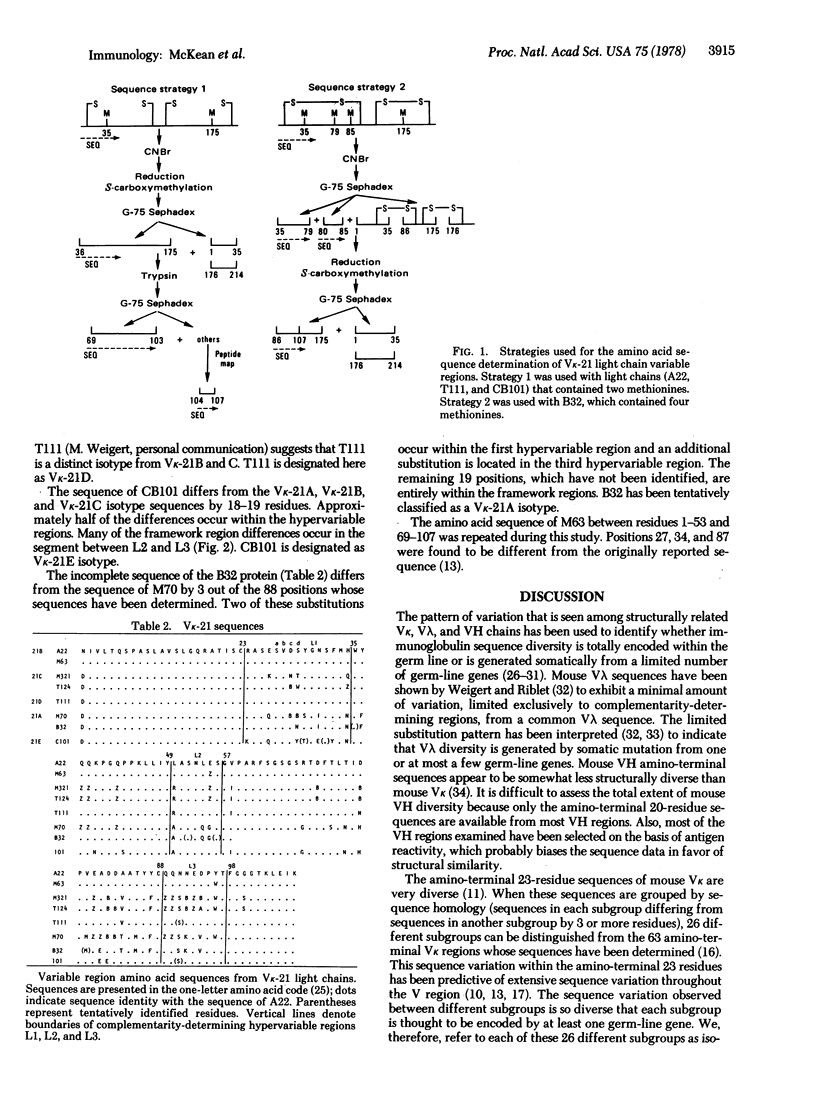
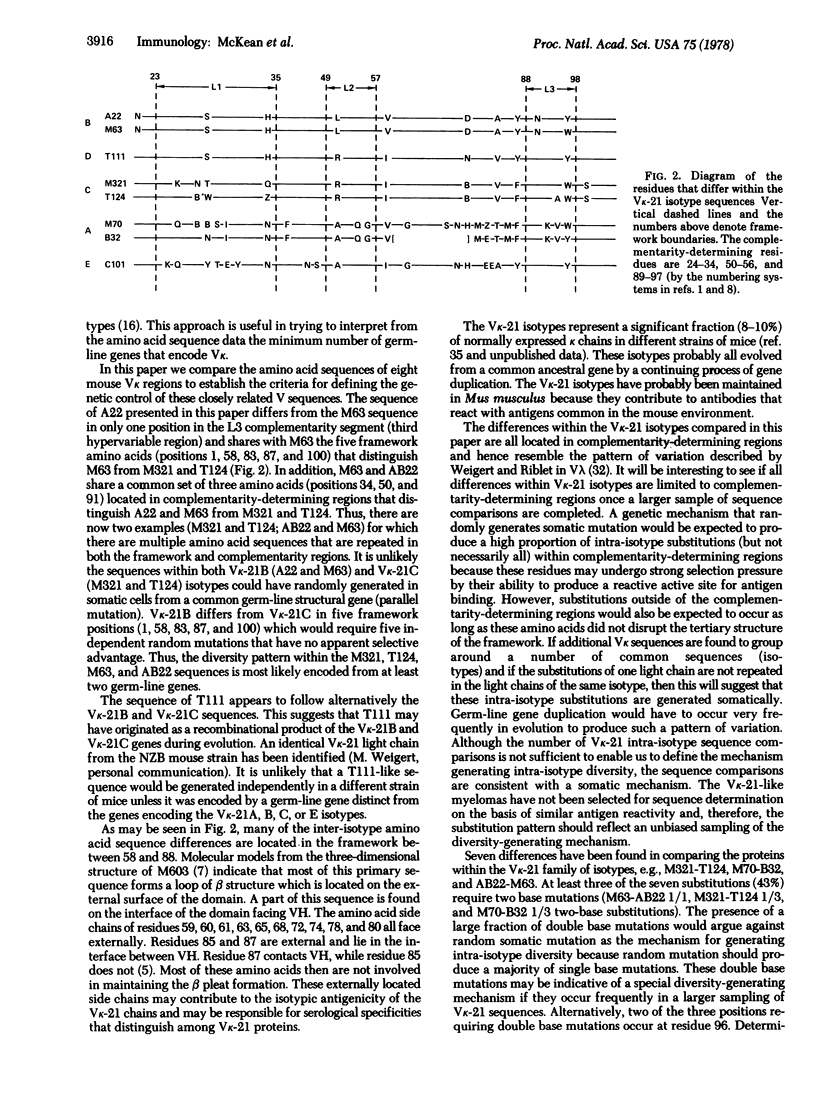
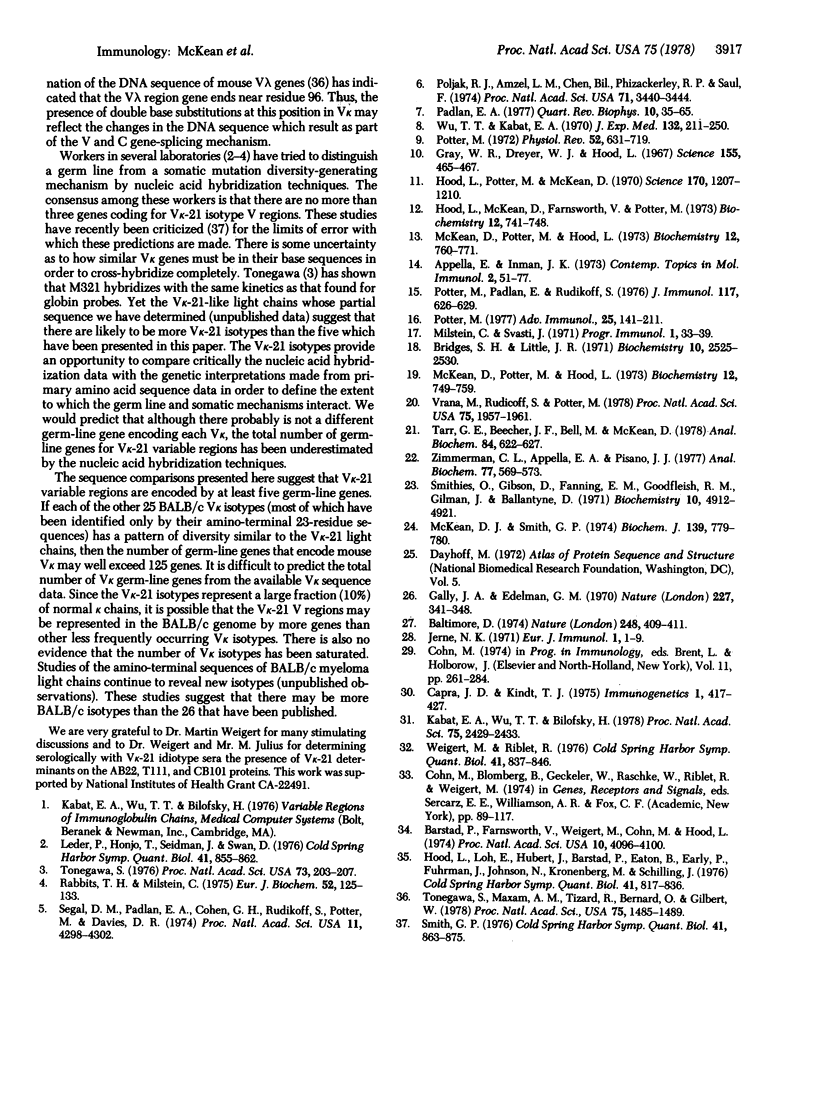
Selected References
These references are in PubMed. This may not be the complete list of references from this article.
- Appella E., Inman J. K. The primary structure of rabbit and mouse immunoglobulin light chains: structural correlates of allotypy. Contemp Top Mol Immunol. 1973;2:51–77. doi: 10.1007/978-1-4684-7773-3_3. [DOI] [PubMed] [Google Scholar]
- Baltimore D. Is terminal deoxynucleotidyl transferase a somatic mutagen in lymphocytes? Nature. 1974 Mar 29;248(447):409–411. doi: 10.1038/248409a0. [DOI] [PubMed] [Google Scholar]
- Barstad P., Farnsworth V., Weigert M., Cohn M., Hood L. Mouse immunoglobulin heavy chains are coded by multiple germ line variable region genes. Proc Natl Acad Sci U S A. 1974 Oct;71(10):4096–4100. doi: 10.1073/pnas.71.10.4096. [DOI] [PMC free article] [PubMed] [Google Scholar]
- Bridges S. H., Little J. R. Recovery of binding activity in reconstituted mouse myeloma proteins. Biochemistry. 1971 Jun 22;10(13):2525–2530. doi: 10.1021/bi00789a016. [DOI] [PubMed] [Google Scholar]
- Gally J. A., Edelman G. M. Somatic translocation of antibody genes. Nature. 1970 Jul 25;227(5256):341–348. doi: 10.1038/227341a0. [DOI] [PubMed] [Google Scholar]
- Gray W. R., Dreyer W. J., Hood L. Mechanism of antibody synthesis: size differences between mouse kappa chains. Science. 1967 Jan 27;155(3761):465–467. doi: 10.1126/science.155.3761.465. [DOI] [PubMed] [Google Scholar]
- Hood L. E., Potter M., McKean D. J. Immunoglobulin structure: amino terminal sequences of kappa chains from genetically similar mice (BALB/c). Science. 1970 Dec 11;170(3963):1207–1210. doi: 10.1126/science.170.3963.1207. [DOI] [PubMed] [Google Scholar]
- Hood L., Loh E., Hubert J., Barstad P., Eaton B., Early P., Fuhrman J., Johnson N., Kronenberg M., Schilling J. The structure and genetics of mouse immunoglobulins: an analysis of NZB myeloma proteins and sets of BALB/c myeloma proteins binding particular haptens. Cold Spring Harb Symp Quant Biol. 1977;41(Pt 2):817–836. doi: 10.1101/sqb.1977.041.01.092. [DOI] [PubMed] [Google Scholar]
- Hood L., McKean D., Farnsworth V., Potter M. Mouse immunoglobulin chains. A survey of the amino-terminal sequences of kappa chains. Biochemistry. 1973 Feb;12(4):741–749. doi: 10.1021/bi00728a026. [DOI] [PubMed] [Google Scholar]
- Jerne N. K. The somatic generation of immune recognition. Eur J Immunol. 1971 Jan;1(1):1–9. doi: 10.1002/eji.1830010102. [DOI] [PubMed] [Google Scholar]
- Kabat E. A., Wu T. T., Bilofsky H. Variable region genes for the immunoglobulin framework are assembled from small segments of DNA--a hypothesis. Proc Natl Acad Sci U S A. 1978 May;75(5):2429–2433. doi: 10.1073/pnas.75.5.2429. [DOI] [PMC free article] [PubMed] [Google Scholar]
- Leder P., Honjo T., Seidman J., Swan D. Origin of immunoglobulin gene diversity: the evidence and a restriction-modification model. Cold Spring Harb Symp Quant Biol. 1977;41(Pt 2):855–862. doi: 10.1101/sqb.1977.041.01.095. [DOI] [PubMed] [Google Scholar]
- McKean D. J., Smith G. P. The use of radiolabelled T1 ribonuclease to monitor the efficiency of Edman degradations. Biochem J. 1974 Jun;139(3):779–780. doi: 10.1042/bj1390779. [DOI] [PMC free article] [PubMed] [Google Scholar]
- McKean D., Potter M., Hood L. Mouse immunoglobulin chains. Partial amino acid sequence of a kappa chain. Biochemistry. 1973 Feb;12(4):749–759. doi: 10.1021/bi00728a027. [DOI] [PubMed] [Google Scholar]
- McKean D., Potter M., Hood L. Mouse immunoglobulin chains. Pattern of sequence variation among kappa chains with limited sequence differences. Biochemistry. 1973 Feb;12(4):760–771. doi: 10.1021/bi00728a028. [DOI] [PubMed] [Google Scholar]
- Padlan E. A. Structural basis for the specificity of antibody-antigen reactions and structural mechanisms for the diversification of antigen-binding specificities. Q Rev Biophys. 1977 Feb;10(1):35–65. doi: 10.1017/s0033583500000135. [DOI] [PubMed] [Google Scholar]
- Poljak R. J., Amzel L. M., Chen B. L., Phizackerley R. P., Saul F. The three-dimensional structure of the fab' fragment of a human myeloma immunoglobulin at 2.0-angstrom resolution. Proc Natl Acad Sci U S A. 1974 Sep;71(9):3440–3444. doi: 10.1073/pnas.71.9.3440. [DOI] [PMC free article] [PubMed] [Google Scholar]
- Potter M. Antigen-binding myeloma proteins of mice. Adv Immunol. 1977;25:141–211. [PubMed] [Google Scholar]
- Potter M. Immunoglobulin-producing tumors and myeloma proteins of mice. Physiol Rev. 1972 Jul;52(3):631–719. doi: 10.1152/physrev.1972.52.3.631. [DOI] [PubMed] [Google Scholar]
- Potter M., Padlan E., Rudikoff S. Localized deletion-insertion mutations: a major factor in the evolution of immunoglobulin structural variability. J Immunol. 1976 Aug;117(2):626–629. [PubMed] [Google Scholar]
- Rabbitts T. H., Milstein C. Mouse immunoglobulin genes: studies on the reiteration frequency of light-chain genes by hybridisation procedures. Eur J Biochem. 1975 Mar 3;52(1):125–133. doi: 10.1111/j.1432-1033.1975.tb03980.x. [DOI] [PubMed] [Google Scholar]
- Segal D. M., Padlan E. A., Cohen G. H., Rudikoff S., Potter M., Davies D. R. The three-dimensional structure of a phosphorylcholine-binding mouse immunoglobulin Fab and the nature of the antigen binding site. Proc Natl Acad Sci U S A. 1974 Nov;71(11):4298–4302. doi: 10.1073/pnas.71.11.4298. [DOI] [PMC free article] [PubMed] [Google Scholar]
- Smith G. P. The significance of hybridization kinetic experiments for theories of antibody diversity. Cold Spring Harb Symp Quant Biol. 1977;41(Pt 2):863–875. doi: 10.1101/sqb.1977.041.01.096. [DOI] [PubMed] [Google Scholar]
- Smithies O., Gibson D., Fanning E. M., Goodfliesh R. M., Gilman J. G., Ballantyne D. L. Quantitative procedures for use with the Edman-Begg sequenator. Partial sequences of two unusual immunoglobulin light chains, Rzf and Sac. Biochemistry. 1971 Dec 21;10(26):4912–4921. doi: 10.1021/bi00802a013. [DOI] [PubMed] [Google Scholar]
- Tarr G. E., Beecher J. F., Bell M., McKean D. J. Polyquarternary amines prevent peptide loss from sequenators. Anal Biochem. 1978 Feb;84(2):622–7?0=ENG. doi: 10.1016/0003-2697(78)90086-6. [DOI] [PubMed] [Google Scholar]
- Tonegawa S., Maxam A. M., Tizard R., Bernard O., Gilbert W. Sequence of a mouse germ-line gene for a variable region of an immunoglobulin light chain. Proc Natl Acad Sci U S A. 1978 Mar;75(3):1485–1489. doi: 10.1073/pnas.75.3.1485. [DOI] [PMC free article] [PubMed] [Google Scholar]
- Tonegawa S. Reiteration frequency of immunoglobulin light chain genes: further evidence for somatic generation of antibody diversity. Proc Natl Acad Sci U S A. 1976 Jan;73(1):203–207. doi: 10.1073/pnas.73.1.203. [DOI] [PMC free article] [PubMed] [Google Scholar]
- Vrana M., Rudikoff S., Potter M. Sequence variation among heavy chains from inulin-binding myeloma proteins. Proc Natl Acad Sci U S A. 1978 Apr;75(4):1957–1961. doi: 10.1073/pnas.75.4.1957. [DOI] [PMC free article] [PubMed] [Google Scholar]
- Weigert M., Riblet R. Genetic control of antibody variable regions. Cold Spring Harb Symp Quant Biol. 1977;41(Pt 2):837–846. doi: 10.1101/sqb.1977.041.01.093. [DOI] [PubMed] [Google Scholar]
- Wu T. T., Kabat E. A. An analysis of the sequences of the variable regions of Bence Jones proteins and myeloma light chains and their implications for antibody complementarity. J Exp Med. 1970 Aug 1;132(2):211–250. doi: 10.1084/jem.132.2.211. [DOI] [PMC free article] [PubMed] [Google Scholar]
- Zimmerman C. L., Appella E., Pisano J. J. Rapid analysis of amino acid phenylthiohydantoins by high-performance liquid chromatography. Anal Biochem. 1977 Feb;77(2):569–573. doi: 10.1016/0003-2697(77)90276-7. [DOI] [PubMed] [Google Scholar]


